Fail-proof Apple Strudel
I jealously preserve this recipe from my grandmother, which was given to her by a friend born in Ortisei, who moved to Naples. It’s a wonderful, fragrant, and delicious dessert, my comfort food during the autumn/winter months, here I explain it step by step, so anyone can prepare it, even those who are new to cooking, after all, the recipe is super tested by generations, so fail-proof and flop-proof.
The strudel is a dessert with ancient origins typical of Trentino Alto Adige, made of very thin dough (it must be transparent) rolled, filled with apples, raisins, and melted butter scented with cinnamon. The appearance of the dessert does not do justice to its sublime goodness; the great Artusi wrote about it: “Do not be disheartened if this dessert seems like a concoction in its composition and if, after baking, it seems somewhat ugly, like an enormous leech, or a misshapen serpent, because then you will enjoy the taste.”
The German term “strudel” can be translated as “vortex“, recalling the rolled shape of the dessert. According to tradition, the right consistency of the pastry would be that which allows you to read a love letter inserted inside it in transparency.
If you’re looking for ideas for a homemade healthy breakfast, click on my Special. “Pantry Sweets“.
If you’re looking for tested and sure success recipes (sweet or savory), click on the Special: “My TOP Recipes“.
If you’re looking for other apple cakes or other fruit, click on my Special: “Desserts with APPLES and/or FRUIT“
You might also be interested in:
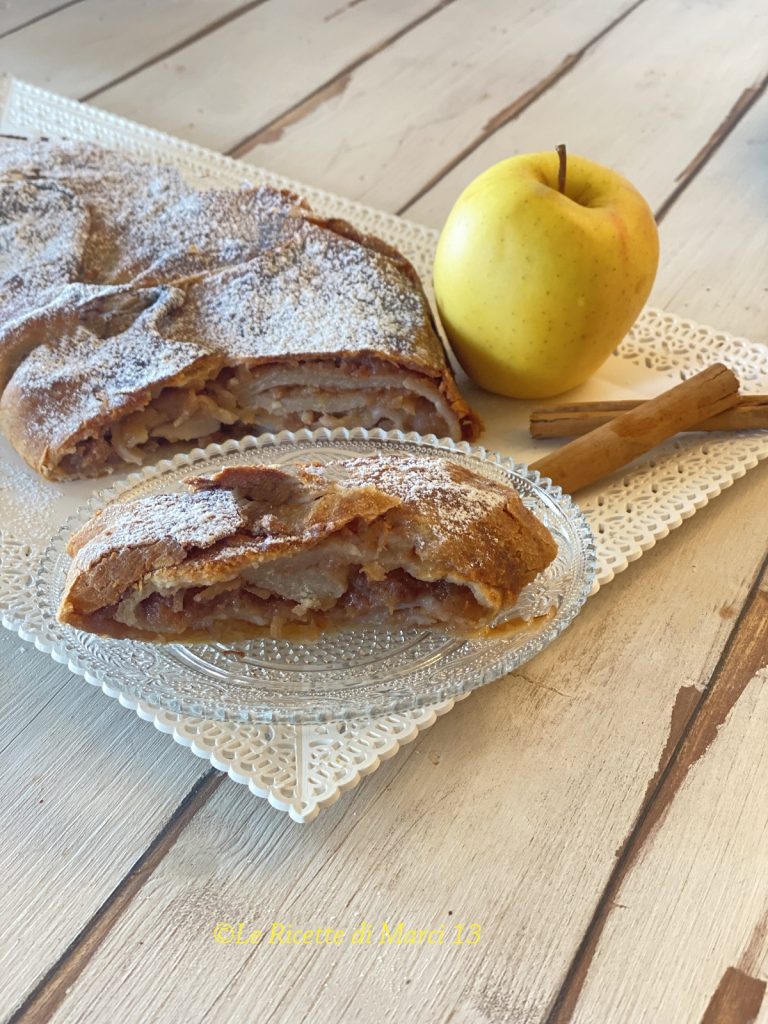
- Difficulty: Easy
- Preparation time: 30 Minutes
- Portions: 8 servings
- Cooking methods: Oven
- Cuisine: Italian
- Seasonality: Autumn, Winter
Ingredients for the Fail-proof Apple Strudel
- 2 1/4 cups all-purpose flour
- 3 1/2 oz butter (quality)
- 1 egg (whole)
- 1/2 cup whole milk
- 1/2 tsp fine salt
- 1 tbsp granulated sugar (optional)
- 1/2 tsp vanilla extract (optional)
- 2.6 lbs Renette apples (or golden yellow, 1.5 lbs cleaned)
- 1 packet ground cinnamon
- 5 1/2 oz butter (quality)
- 3 oz Corinthian raisins (or sultanas)
- 1 cup powdered sugar (or granulated)
- 1 lemon zest (grated)
- 1 1/3 oz rum (or grappa, optional for flavoring raisins)
- 1/2 cup walnuts (chopped, optional)
- to taste vanilla powdered sugar (to garnish the surface)
- 1 cup fresh cream for whipping (to accompany the strudel, optional)
Tools
- Bowl
- Knife
- Corer
- Cutting Board
- Stand Mixer Kenwood with Illuminated Bowl W 1400, 7-liter bowl
- Saucepan
- Rolling Pin
- Parchment Paper
- Pastry Brush
- Baking Tray Masterclass non-stick
Steps for the Fail-proof Apple Strudel
First of all, soak the raisins for 10 minutes in boiling water, then drain the water, take a small bowl, pour the raisins, and add the rum and a small spoonful of granulated sugar, let it marinate for 30 minutes.
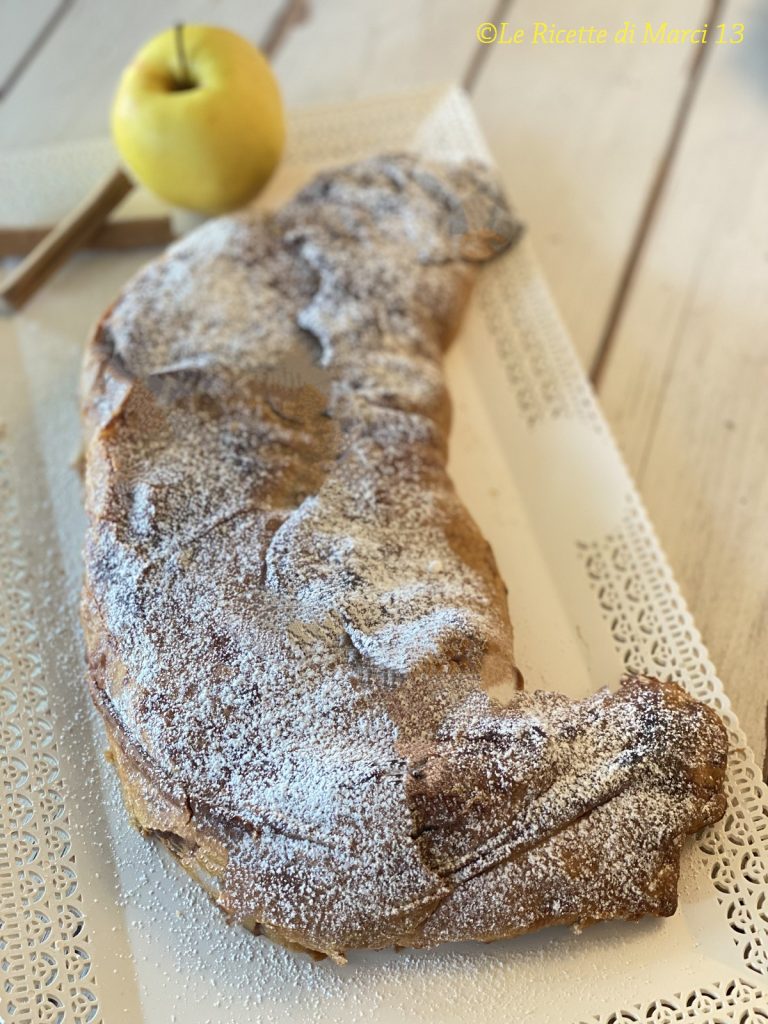
Meanwhile, wash and peel the apples, remove the core (they should weigh about 1.5 lbs in the end), then cut them into thin slices, transfer them to a bowl, add the raisins with their rum, the grated zest of one lemon, the packet of cinnamon, 1 cup of sugar (if desired, you can also add chopped walnuts) and mix everything, cover with cling film and let it marinate for 30 minutes at room temperature.
Now focus on the strudel dough:
Take a saucepan and melt 1 1/3 oz of butter in the milk in a double boiler.
Then put in the bowl of the stand mixer: the flour, a pinch of salt, the milk and butter mixture cooled, one whole egg, 1 tbsp of granulated sugar, and the vanilla (optional). Mix everything with the paddle attachment for at least 15 minutes, it should result in a smooth and homogeneous mixture that does not stick to the hands or the sides of the bowl. If desired, you can work the dough by hand vigorously for at least 20 minutes.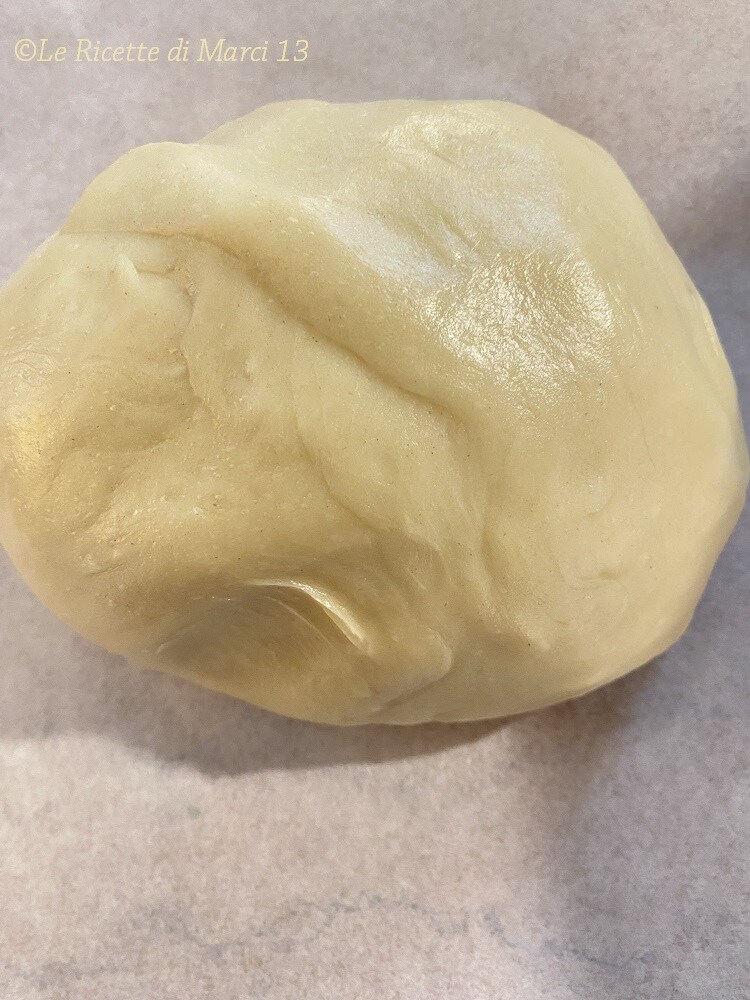
Heat a pot, sprinkle the work surface with flour, place the dough on the work surface, and cover it with the hot pot, let the dough rest for 30 minutes to gain elasticity. The warm dough will be more pliable.
Meanwhile, melt the remaining 5 1/2 oz of butter in a double boiler. After the dough has rested for half an hour, take a clean cloth, flour it, and roll the dough into a rectangle with a rolling pin, then stretch it with the back of floured hands until it is very thin, it should be so transparent that you should see the cloth underneath, as in the photo (see red arrow in photo).
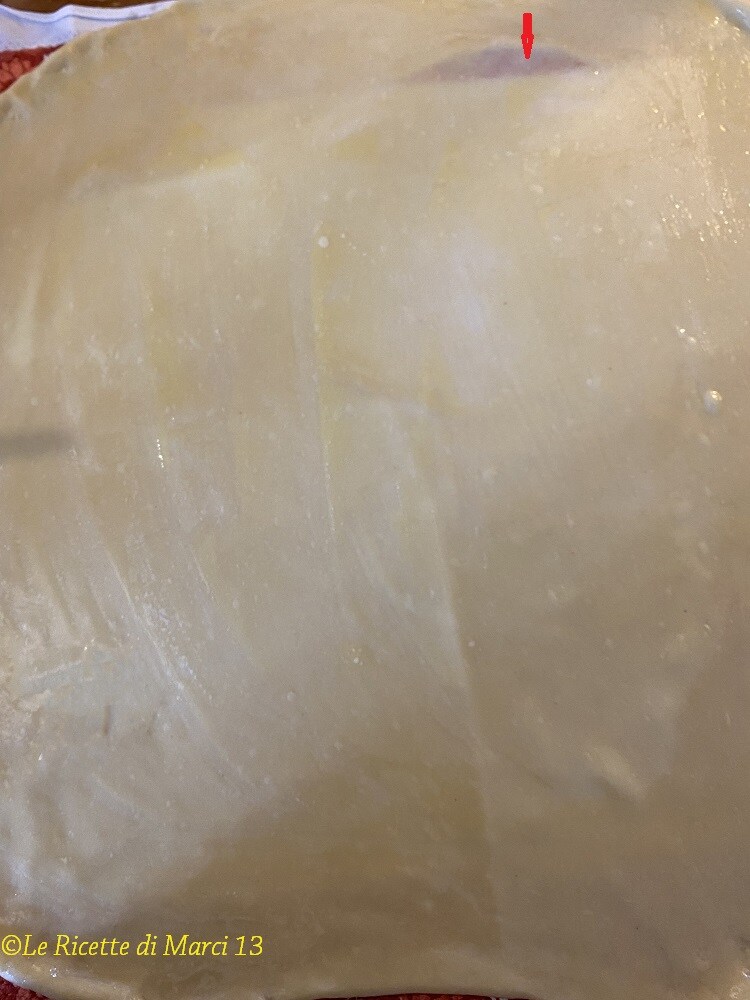
Brush the surface of the strudel with 2/3 oz of melted butter (taken from the 5 1/2 oz), evenly distribute all the apple and raisin filling along with their marinating liquid. Finally, pour 3 1/3 oz of melted butter (keep the remaining 1 1/3 oz of butter to brush the surface of the roll).
Fold the side edges inward to cover the apples by a few inches, so as not to risk the filling coming out of the strudel. Then roll the dough onto itself from bottom to top, using the cloth to assist.
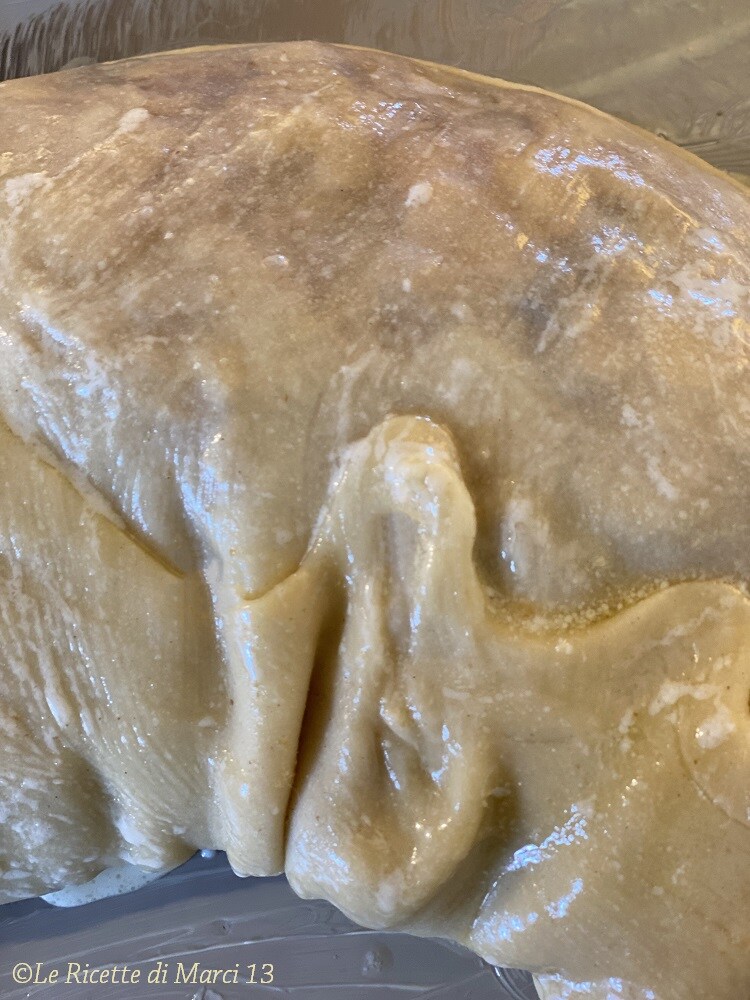
At this point, still using the cloth, transfer the strudel onto a baking tray (or sheet) covered with parchment paper and then well-buttered, ensuring the seam side is down. Finally, brush the entire surface of the strudel with the remaining 1 1/3 oz of melted butter.
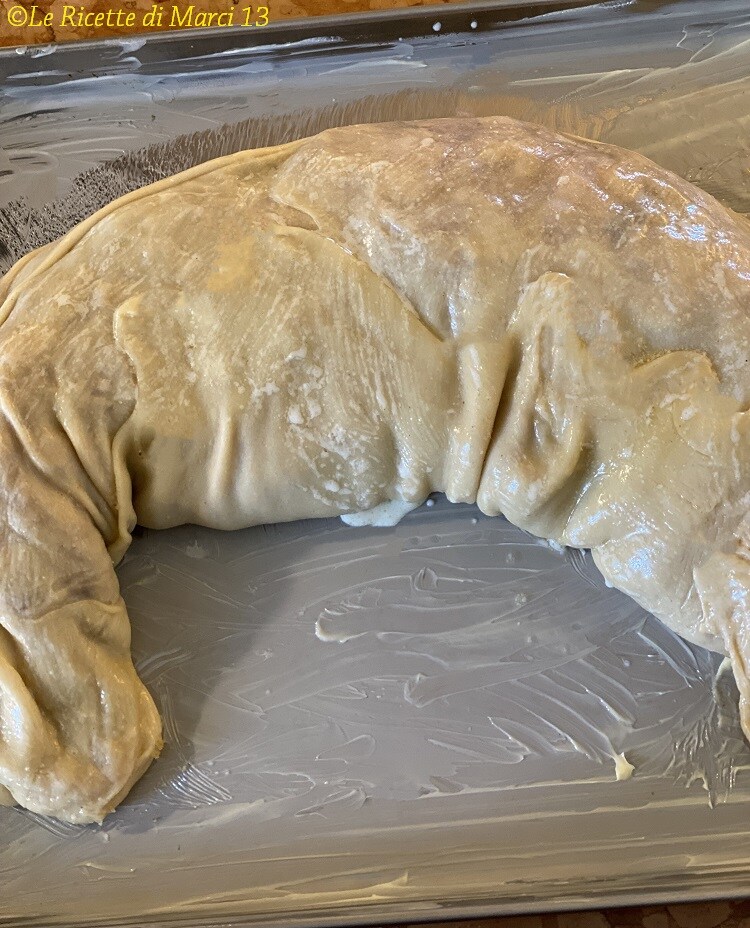
Transfer the tray to a preheated static oven at 350°F for 50 minutes. As the strudel bakes, occasionally open the oven and use a spoon to collect the liquid that comes out of the dessert and brush the surface, forming a delicious semi-caramelized crust (optional) by the end of the cooking process.
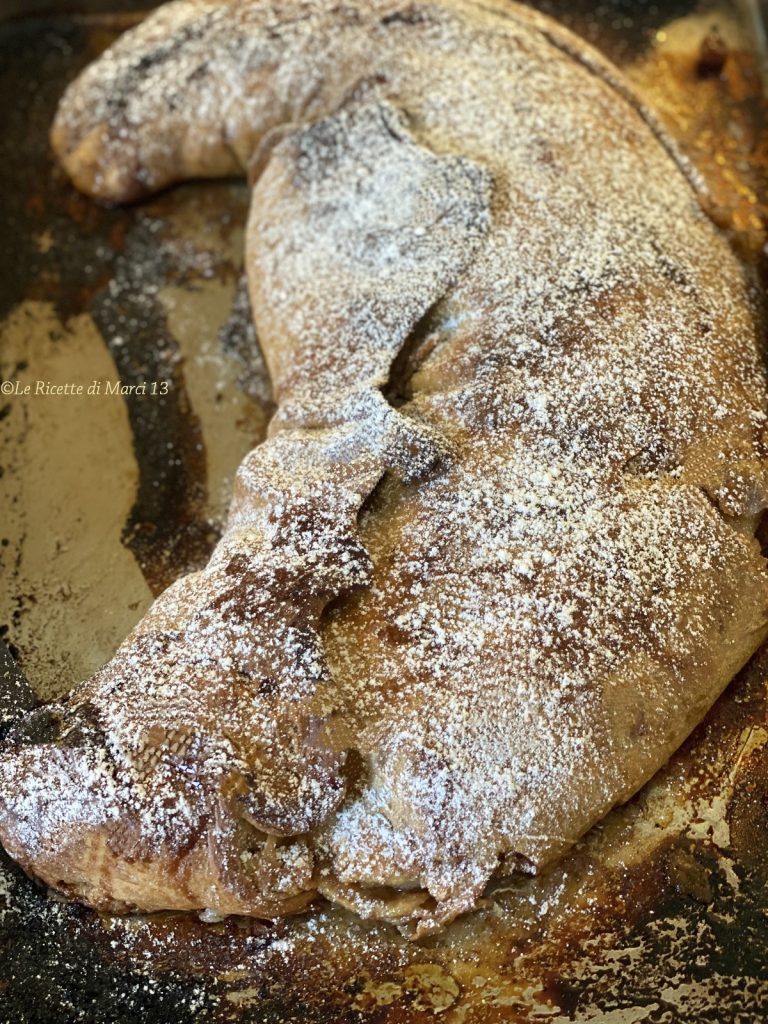
Remove the strudel from the oven and let it cool for at least a couple of hours before serving, sprinkled with powdered sugar, to allow it to set well and to be more easily sliced.

If desired, you can accompany the apple strudel with semi-whipped fresh cream with a spoonful of sugar.

This is the slice (unfortunately the photo came out blurry) … a real delight for the palate.
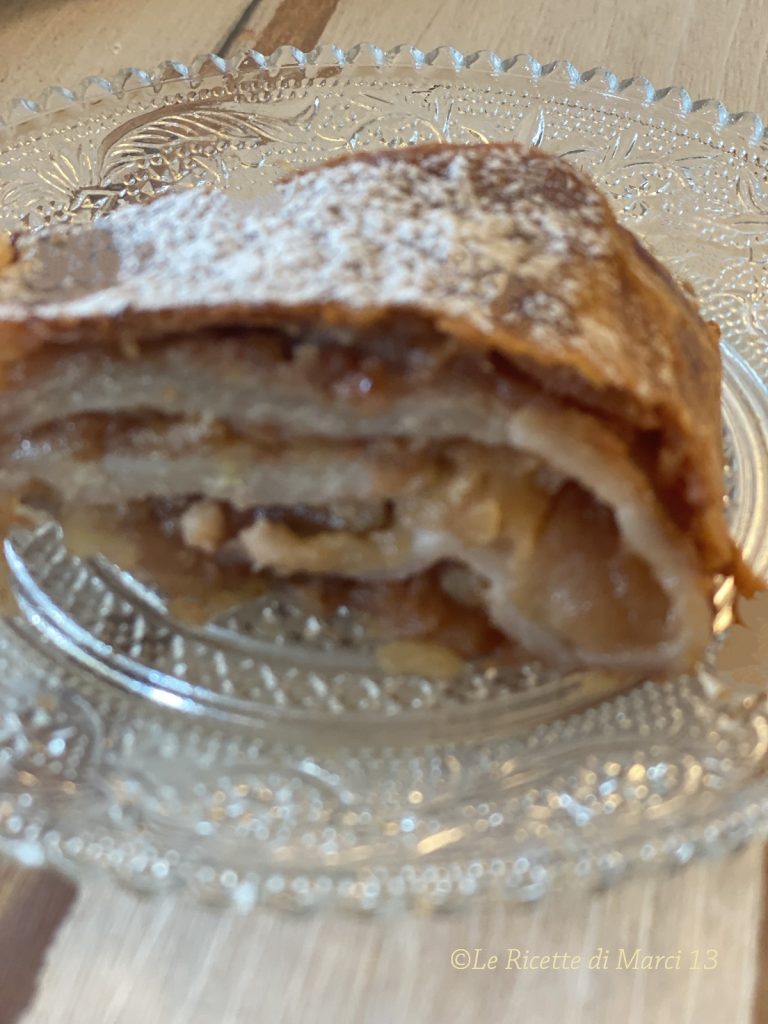
Shopping Tips!!!
To weigh the ingredients for my preparations, I use this handy digital kitchen scale, with a large removable bowl, tare function, and built-in timer, you can find it on Amazon at a great price
To work the dough effortlessly, I use my Titanium Chef Patissier XL stand mixer with illuminated 7L bowl, 1400W power, integrated scale and blender, a faithful ally in the kitchen for: kneading, weighing, whisking, cooking, chopping, melting chocolate, pasteurizing eggs.
If you are looking for a more affordable stand mixer model, you can comfortably choose to purchase Kenwood Titanium Chef Baker, with double bowl of 5l and 3.5l and 1200W of power, integrated scale.
To bake the strudel, I used this spacious MasterClass non-stick baking tray which you can always find on Amazon at a great price.
FAQ (Questions and Answers)
Origins and history of the Strudel?
The history of strudel starts from the Asian regions, where desserts characterized by the use of puff pastry with filling date back to the distant times of Mesopotamia. An Assyrian manuscript from the 8th century BC was found, mentioning a dessert prepared for the Assyrian court that consisted of several thin layers of puff pastry filled with nuts and honey. From that moment, the use of this slightly crunchy type of pastry probably expanded to Turkey, Greece, and throughout the Mediterranean. These desserts became known as Baclava and spread quickly thanks to merchants and fleets involved in trade between Asia and Eastern Europe, selling and buying spices, textiles, and other precious goods. The small puff pastry desserts quickly traveled from Turkey to Hungary, where they also became larger.
In 1699, Hungary became part of the Austrian Empire, and from there, the spread to Vienna was very rapid. In the city, the desserts were soon called strudel, due to their shape, since the word means roll or vortex. It was the Austrian pastry chefs who made the last significant adjustments to the dessert, making it famous worldwide. The Viennese recipe involves the use of a very thin puff pastry and typical ingredients of the area. Apples, raisins, and pine nuts are used for the preparation of the typical Apfelsrudel; there are also different variations in which cherries, for example, are added, or cheese. (see here)

